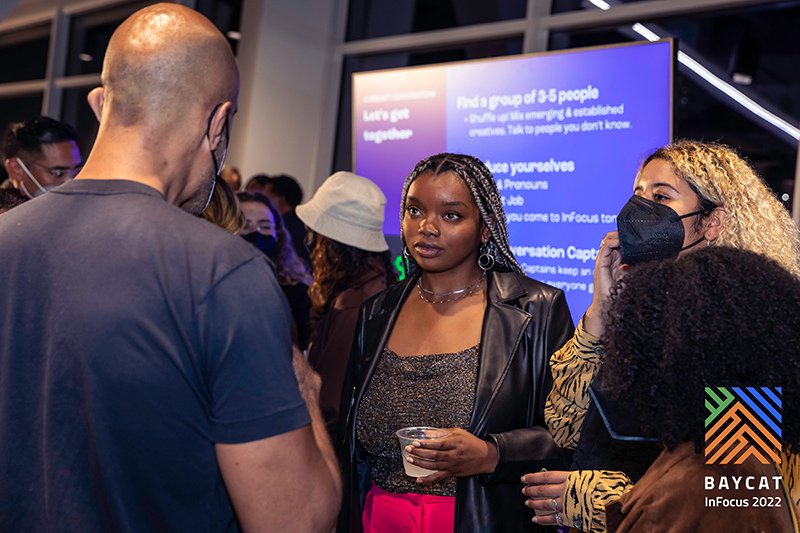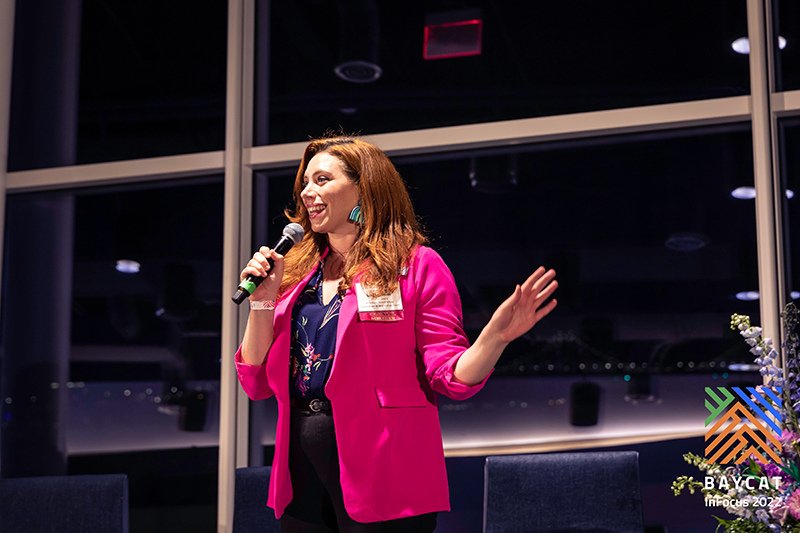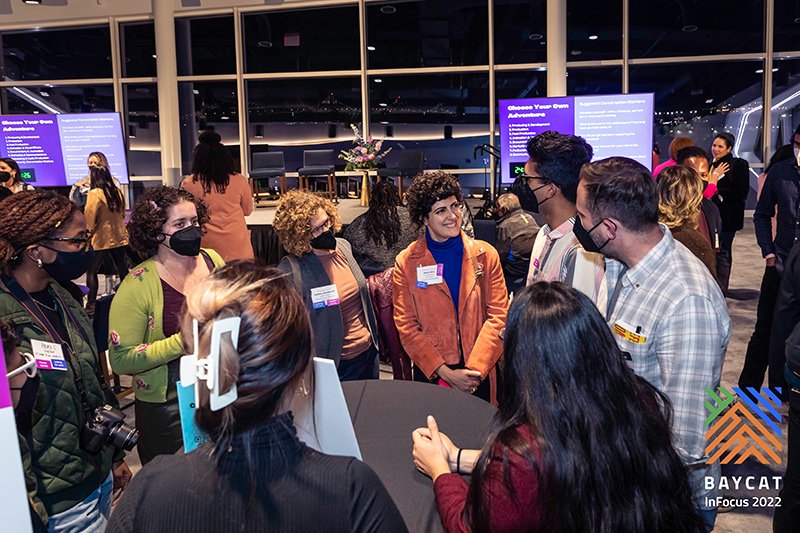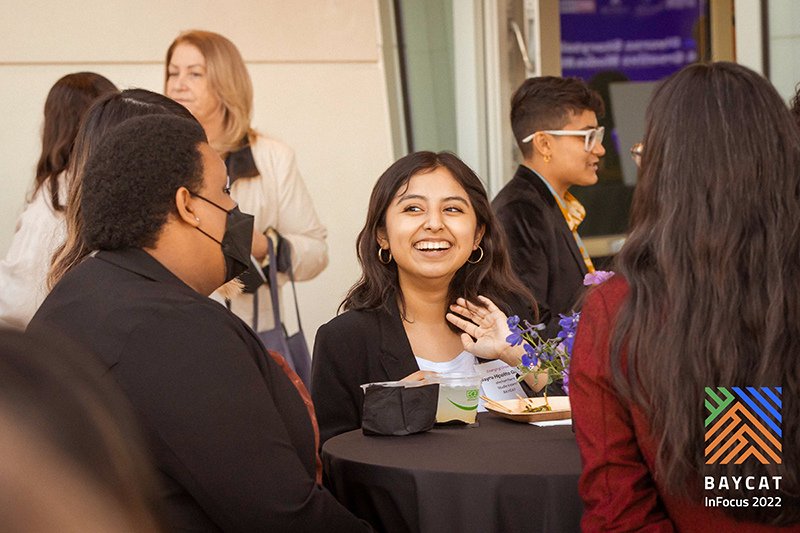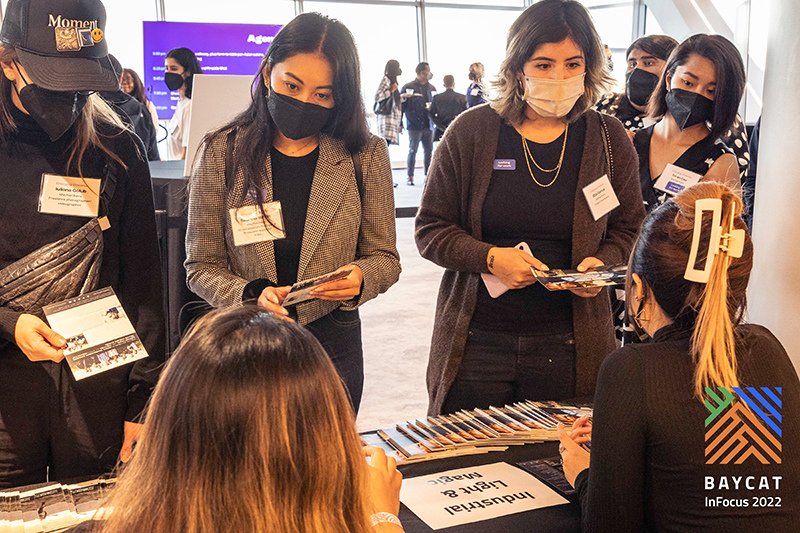How to use storytelling to shape a better networking event
PROJECT RECAP: BAYCAT InFocus
In a recent interview, chatted with Jessica Pullano and Sierra Lee about how we collaborated to create BAYCAT InFocus in the fall of 2022.
BAYCAT InFocus was a new kind of networking event that brought together diverse storytellers, industry professionals, and community members to connect, share stories, and build meaningful relationships. We invited younger emerging creatives to mix and mingle with creatives who are more established in their careers. We wanted a variety of voices in the room because there is a beautiful alchemy of connections when people from different backgrounds get together to find their common connections.
We aimed to create a space where attendees could share their personal stories, build trust, and foster meaningful connections. Through structured activities and discussions, the event provided valuable insights on how to plan a better networking event that truly resonates with participants.
I consulted with BAYCAT on the event structure, guiding questions, creatives directory, and long-term outcomes of the event. We put a focus on using storytelling to help us shape the experience into something lasting and memorable.
BAYCAT InFocus is returning to the Chase Center for a second year on Wednesday, July 19th.
Three ways you can build a networking event based in storytelling:
Break from the traditional networking mold and focus on sharing stories instead of resumes titles
Networking events centered around storytelling can facilitate deeper connections between participants. Jessica Pullano emphasizes the transformative power of sharing stories: "And overall, everyone does wanna be known. And so if you're willing to share your story and let people in, there's power in that. And then they might be willing to share their story back to you, and then you actually have a deeper connection with somebody."
Create an intentional structure to the night so people go on a journey, getting more comfortable and open with each new activity.
To encourage authentic storytelling, it's crucial to provide a supportive environment where participants feel safe to share their stories. Liz Morrison emphasizes the importance of striking the right balance: "We approached the structure of the event like a three-act play or a three-act story. We gave enough structure to it so that people felt safe moving from thing to thing, but enough space where they could get creative and be themselves and have a really true experience."
Being memorable leads to more impactful, lasting connections. Use story prompts to facilitate discussions that make it easy for folks to connect on a human level.
Connecting over personal stories makes individuals memorable, leading to lasting connections. “Our stories are the things that make us care about each other. And once we care about each other, then we're actually motivated to build a better future,” says Liz Morrison. By creating an environment where people can authentically share their stories, networking events can go beyond surface-level interactions. These genuine connections have the potential to unlock opportunities and foster long-term relationships, ultimately contributing to personal and professional growth.
Read on as we dive deeper into the insights gained from the BAYCAT InFocus event, exploring the importance of storytelling, the role of vulnerability, and the ways in which authentic connections can shape our personal and professional lives.
The following is the transcript of our conversation, slightly edited for length and readability.
Where did InFocus come from?
“How do we build actual connections amongst one another potentially to advance careers or to find folks for your next passion project? ”
Liz Morrison: Where did the idea for InFocus come from? What was the impetus, the need that you all saw, and what were some of the initial goals of the event that you came up with?
Jessica Pullano: In the beginning it was really about we missed each other, right? We went through the pandemic and all the shutdown years. Now our programs were back in person, but we hadn't had a large-scale event with all parts of our community in a really long time.
So part of this was a reunion sort of feeling of like, how do we all come back together? And then it grew into InFocus, which was more than just a fun reunion space.
How do we build actual connections amongst one another potentially to advance careers or to find folks for your next passion project? Ultimately, what ended up happening was having big meaty discussions about representation in the media and how this community could be a part of making the spaces and the crews that we want to be on.
Liz Morrison: It was so fun to see the event evolve, starting with, oh, let's just have an event that brings people together to actually craft a real experience for people.
Why do networking events usually suck?
“If we’re going to make this a networking event, how do we do it in a way that brings as many voices as possible into the room? That really focuses on our individual stories, right? So, when you’re talking to someone new, you have a jumping-off point that’s a little bit more than hello and where do you work?”
Liz Morrison: Sierra, can you talk about why do networking events generally suck and how are we trying to have a not sucky event?
Sierra Lee: Ooh. Yeah. Where do I begin?
I'll speak for myself, but I think a lot of people would agree that it kind of doesn't matter where you're at in your career, walking into a room of strangers and having to pitch yourself can be hard to do in a way that feels authentic and not like you're putting on a face or putting on a mask.
And so we really wanted to bypass awkwardness that is just seemingly so inherent in networking events. But also recognize that a lot of our social skills have atrophied a little bit too over the course of the pandemic.
Ultimately, where that led us was if we're going to make this a networking event, how do we do it in a way that brings as many voices as possible into the room? That really focuses on our individual stories, right? So, when you're talking to someone new, you have a jumping-off point that's a little bit more than hello and where do you work?
And I think we did that really successfully with some facilitated networking.
How did we use storytelling in the InFocus planning?
Liz Morrison: What was the planning process like? How did we bring in the board, the builders, the BAYCAT staff, the community? It was a really intentional process. So can you talk about how we went around doing that?
“I think networking can be really painful. So I took some of the things I’ve learned from the storytelling events and workshops I’ve hosted and applied that to this community. One of the ways that we approached the structure of the event was actually really thinking about it like a three-act play or a three-act story. ”
Jessica Pullano: So for one, we got this amazing opportunity to work with you, Liz, and think through how we could actually facilitate the networking part, give it some structure so that it helped people get past that awkward get-to-know-you kind of stuff.
And Liz, you helped us think about what is the structure to do that in. How do you create safety and help people go deeper with each other, even though some of them might have just met.
Liz Morrison: I think networking can be really painful. And so I took some of these things that I've learned from the storytelling events that I've hosted, the workshops I've hosted, and applied that to this community that I care so much about and really want to see connected and sharing their stories.
One of the ways that we approached the structure of the event was actually really thinking about it like a three-act play or a three-act story.
The first sort of context setting act the night was when Villy got up and did a beautiful intro.
Then we brought up a panel of BAYCAT alums to talk about their experience breaking into the media industry, some of the challenges that they've faced, but also some of the successes, right? They talked about what happens when you have a network there supporting you in your career.
Next, we got into the community conversations, which is the portion that I led.The goal was to create this real human connection before we get into the “what do you do?” questions.
From there, we moved into the skill-based specific networking. This is where people were able to make more concrete connections with people in the types of stuff that they like to do.
And then we wrapped it up with a fun raffle and more mingling.
And it really was a full experience of the night. And, I think that story-based planning really helped.
And I'm just grateful for you all that you allowed me to come in and be like, “I have ideas. Let me take over the, structure of this event a little bit and really put it together.”
Jessica Pullano: Yeah, we were super thankful for it. It wasn't, you didn't have to a lot of convincing. It was amazing cuz you brought such relevant ideas and we wanted this, this idea of how do you get past boring networking and make it meaningful.
I mean, of course, BAYCAT loves stories. We're storytellers in a certain realm. So how do we bring those elements into a room and think about it even in terms of networking? How do you get to somebody's actual story where it's not a facilitated video that we're shooting?
So we appreciated that you had those experiences of helping people make those connections in real life and thinking about how they brought their stories into the room and could apply it in this setting, which was really fun.
How did we shape the community conversations to create connections?
Liz Morrison: As I shaped the community conversations, I was very intentional about what questions we asked and how we led people in the discussion.
To kick off that section, I did the thing that I do, which is I set agreements.
I said, “I know it's scary to talk to strangers, but here's what we're gonna agree on so everyone feels safe.”
We started by asking people: Describe a project you’ve worked on that you’re really proud of.
As opposed to just saying “oh, what do you do?” And I think that brought this beautiful buzz in the room. Because people light up when they talk about things that they are proud of.
And we moved then into talking about challenges. What's a challenge that you faced in your career?
And I was listening to some conversations and that was a really interesting question because for the established folks, they still have challenges, right? And to be able to honestly share that with the emerging folks was powerful. And similarly for the established folks to hear what the emerging folks had been going through was useful.
This event was not about it being a one-time thing. So the next question was “What is your goal in the next six months and how can the people in this room help you achieve that goal?”
And I think that really got people thinking a little differently about, oh, this isn't just a normal networking event. This is a community that I am now a part of.
Jessica Pullano: In talking to folks afterward, they loved the conversations! They felt like they could have spent the entire night doing them. So I think people really resonated with both the questions, but how it built the connections with their little group.
Sierra Lee: I think at our core, we all just wanna be seen, right? I think most people love actually talking about themselves. But sometimes you need permission to go there. And I think the questions allowed people to go deeper than they might have if we had just put them in a room together without a prompt or facilitation.
How was our interest and skills-based networking section different from traditional networking?
Liz Morrison: That leads into the next part of the night, which was the interest and skills-based networking. So if you like production, go over here, if you like documentary, go over here. What happened then?
“By doing the small groups first and allowing folks to get deeper and have a truer sense of safety, it built a level of trust. Even though they were going to two potentially entirely different groups of people, it set a tone for the night that they could get vulnerable, they could talk to people in a real way. ”
Jessica Pullano: It was awesome. There are big clusters of people. Everybody was leaned in and really engaged, like all the. Body language showed all their engagement. I think it was really powerful.
By doing the small groups first and allowing folks to get deeper and have a truer sense of safety, it built a level of trust. Even though they were going to two potentially entirely different groups of people, it set a tone for the night that they could get vulnerable, they could talk to people in a real way.
So even though this was a little bit more traditional networking, where you're talking about a job or you're talking about a role, I think it came with a much more genuine friendly feeling because we had done the small group in such a different fashion. So I think that actually really helped to do the combination
Sierra Lee: Think a traditional networking event would've started like that. You would've walked in and that would be the first thing you did, and it wouldn't be facilitated. It would just be people milling around a room. And I think we all know how that would've felt, not nearly as exciting or authentic or electric as it turned out to be.
Describe the vibe in the room.
Liz Morrison: Who was in the room? What was the vibe like? Why was that room different from many other rooms that we have all been in our life and why was that so special?
“It was just the most talented room in San Francisco that night.”
Sierra Lee: When you walk into a room where people don't look like you, and that can be for any reason, right? Maybe it's a room full of men and you're trans or non-binary or a woman, or you're a person of color and you walk into a room and it's all white people like you feel that very much in your body.
And I think just being able to look around the room that night, it was so diverse. It was truly representative of the Bay Area community, of the community that I think BAYCAT is trying to cultivate. And that just felt so powerful.
And I feel like there was an electricity in the room. Everyone was so excited to be there. It was hard to get people to leave at the end. The room was just buzzing. It was pretty special.
Liz Morrison: I remember, when I went up on stage for the community conversations, looking out at the sea of faces, 200 people. It was not a small event. It was just the most talented room in San Francisco that night. It was incredible to see the wide variety of folks there and the different things they were interested in.
What was the feedback from the event attendees?
Liz Morrison: The event was so special. There's not a good word for the magic buzzy electric energy. I wish there was like a special word for it cuz it was just such a unique feeling in the room.
What did people say after the fact? What were some of the responses? What did we hear from especially the emerging creatives about what they got out of this experience?
Jessica Pullano: We got a lot of good feedback about the event in general. It was powerful to be in a room that was so diverse, that they saw themselves in folks, and that wasn't a space they had been in very often, if ever, and certainly not career related. So that was really powerful.
Folks often commented on how genuine everyone was and how everyone was excited to talk with one another, whether they were established or emerging. Everybody was open and excited to make the connections, which doesn't always feel the case.
What did the sponsors especially like about the event?
Liz Morrison: We had some absolutely incredible, amazing sponsors for this event. So can you talk a little bit about who signed on to be a sponsor and what was their reaction? Because I know obviously if they're plopping down the money that they plopped down, they were looking for some outcome here too. And what sort of outcome did they get?
Jessica Pullano: We were really excited to get to partner with Pixar and Industrial Light Magic, many different parts of the Disney brand and team. Marvel was there. We also had LinkedIn, Amazon Studios, and all sorts of folks come out for this. And that was really powerful because they are absolutely looking to build their teams in the creative media space.
Talking with the Pixar and the ILM teams afterward, they were a buzz. The recruiting teams go to these sorts of events a lot. A couple of recruiters, in particular, came up to me and said, people are always scared to talk to me. We don't get very deep with one another, and that wasn't the case here, that's the way this was set up. I was excited to be a part of these conversations and learned so much more about folks than I normally do. So that was really cool.
But they were excited by BAYCAT and how it was such a diverse room. The energy was totally different. We did that at the Chase Center Above the Rim, so it wasn't a boring conference room. It was an amazing, beautiful space with beautiful people in it. So it was really fun, like on all sorts of fronts.
What surprised you or excited you about being a part of InFocus?
“I’m really proud of InFocus because it broke from a lot of the traditional non-profit event models. It wasn’t a gala, it wasn’t a get-up on stage and talk about how amazing these programs are. It WAS the program, right?
It was this amazing, powerful way to support emerging creatives, support established creatives, to build a bigger sense of community and connections.”
Liz Morrison: Can you just tell me personally, what was it like for you both to work on this event and what surprised you? What were you particularly proud of? Just like how do you feel about this event?
Sierra Lee: It was really exciting. I think it was a little scary to plan a huge event like this. You know, coming out of the first couple of years of the pandemic. I think all of the traditional event strategies don't apply in all the same ways.
And so I think having a lot of thought partners helped. We worked with staff, we worked with the Board and the Builders. We worked with you so closely, Liz. Having many stakeholders and folks invested in the shape and the experience of this event, I think really just added to the success and the magic.
Jessica Pullano: I'm really proud of InFocus because it broke from a lot of the traditional non-profit event models. It wasn't a gala, it wasn't a get-up on stage and talk about how amazing these programs are. It WAS the program, right?
It was this amazing, powerful way to support emerging creatives, support established creatives, to build a bigger sense of community and connections. It was exciting to be a part of it. It absolutely was a little crazy to pull together.
There's no way we could have ever done it without you, Liz, or you, Sierra, you were both so integral to making that event happen. But really exciting and powerful to pull together a big event after not having had big in-person events for years.
Talk about what it was like collaborating with Liz and using story to structure the event.
Jessica Pullano: We're so lucky to get a chance to work with you, Liz. BAYCAT does storytelling for video, and certainly, our fundraising team thinks about story all the time in terms of encouraging people to donate their time or their money.
But it is different to think about that in a live space. And you were able to translate it in such a way that was really powerful and exciting. You helped us think differently about those personal connections and how we can help give enough structure to the event so that people felt safe participating, but with enough space where they could get creative and be themselves and have a really true experience.
I also appreciated, not just that you brought great ideas to the table, but you were willing to roll up your sleeves and help us think about how to get it done.
“With so many voices in the room, this was such a collaborative event in the building of it. And Liz, one of your talents is being able to hear what everyone is contributing and synthesize it. And then find a way to make it work within the structure. That is not an easy thing to do, but you make it look very effortless.”
You were at our focus groups and helped us think about how to put those together. You helped us think about the directory. You were willing to roll up your sleeves and actually help us build it.
You were willing to be at every stage of the process, which felt very collaborative. And that energy you brought helped. it was exciting to co-create together.
Sierra Lee: I would just add that with so many voices in the room, this was such a collaborative event in the building of it. And Liz, one of your talents is being able to hear what everyone is contributing and synthesize it. And then find a way to make it work within the structure. That is not an easy thing to do, but you make it look very effortless.
Liz Morrison: Thank you so much. I really appreciate that.
What's next for InFocus this year?
Liz Morrison: Sierra, can you talk about what is next for InFocus? How are we coming back bigger and better this year?
Sierra Lee: InFocus is coming back in July, we couldn't wait a whole year to have another event. It's going to be July 19th, at the Chase Center once again. Same venue, new name. Now it's Above The Rim.
And we're really excited to add a new element this year. In addition to the personal storytelling, in addition to all of the networking and the potential to meet with folks who you might work with on a creative project or who might have the capacity to hire you, we're really invested in creating a forum for ideas exchange about the most pressing issues in the creative media industry right now.
So we've talked about AI technology, we've talked about representation, hiring trends. We're gonna have a forum to dig into all of that, both from the stage and then together as a crowd.
Liz Morrison: I can't wait to play around with how we craft the right kind of questions for this event. So it'll be a different experience, but one that will really tap into the same energy and bring really smart people together to have these conversations and create connections around them. It's gonna be amazing!
Last Question: Why is it important to take a pause from our busy day-to-day to connect on a deeper level?
“As we navigate in this weird time of, you know, zoom spaces and sometimes in person and all of those different iterations, having a true sense of connection with somebody is harder to do now. And I think storytelling has always been a powerful way to do that.
Overall, everyone does wanna be known. And so if you’re willing to share your story and let people in, there’s power in that. And then they might be willing to share their story back to you. And then you actually have a deeper connection with somebody. That is magic. I don’t care if that’s at work or at home, it’s magic everywhere. And I feel like we could all use a little bit more of that these days.”
Liz Morrison: My last question for you all: So much of this event was about let's take a pause out of our busy day-to-day and find space to learn about each other and connect on this sort of deeper level. So why is it important for people to take that time to really do storytelling and share their stories, and connect over stories? Why is it needed now more than ever?
Jessica Pullano: As we navigate in this weird time of, you know, zoom spaces and sometimes in person and all of those different iterations, having a true sense of connection with somebody is harder to do now. And I think storytelling has always been a powerful way to do that.
Overall, everyone does wanna be known. And so if you're willing to share your story and let people in, there's power in that. And then they might be willing to share their story back to you. And then you actually have a deeper connection with somebody. That is magic. I don't care if that's at work or at home, it's magic everywhere. And I feel like we could all use a little bit more of that these days.
Sierra Lee: I don't know if you all have seen these articles about the loneliness pandemic in this country. How as a whole we are all just like deeply isolated and lonely and how the pandemic has not helped that. And I think that's why so many people love Film and TV, right, is because you get to step outside your own experience.
But how much more powerful is that when you can do that in community with other people? I think that's what we all crave, even if we don't really realize it.
Liz Morrison: It's so powerful. That is the thing that changes the world in my mind.
Our stories are the things that make us care about each other. And once we care about each other, then we're actually motivated to build a better future. We're motivated to do the work.
“Our stories are the things that make us care about each other. And once we care about each other, then we’re actually motivated to build a better future. We’re motivated to do the work.
And I think that, to me, that was so much a part of what InFocus was about. How does it not just become a room of people that you’re never gonna remember? How do we make people memorable? And that was through getting each other sharing stories.
And then ultimately that will have that long tail effect of creating these relationships that will hopefully unlock many opportunities for folks. And I think we’re already seeing that. ”
And I think that, to me, that was so much a part of what InFocus was about. How does it not just become a room of people that you're never gonna remember? How do we make people memorable? And that was through getting each other sharing stories. Because those stories are the things that people are gonna remember.
And then ultimately that will have that long tail effect of creating these relationships that will hopefully unlock many opportunities for folks. And I think we're already seeing that.
So it was such a joy to work on this with you all. I'm so excited for the next one too.
Jessica Pullano: Yes!
Liz Morrison: Well, July 19th, Chase Center Above the Rim. If you're in the Bay Area, you should be there. It's gonna be amazing.
Sierra Lee: See you there.
Liz Morrison: See you there.
Don't miss out on the opportunity to experience the power of connection at this year's BAYCAT InFocus event on July 19, 2023, at the iconic Chase Center Above the Rim. Join us as we gather to share stories, build relationships, and create a community of diverse creative voices.
Mark your calendars and get ready for an unforgettable evening of connection, inspiration, and growth. Together, let's embrace the magic of storytelling and unlock a future filled with a wide range of creative voices changing the stories that get told, and ultimately changing the world
See you at BAYCAT InFocus!

